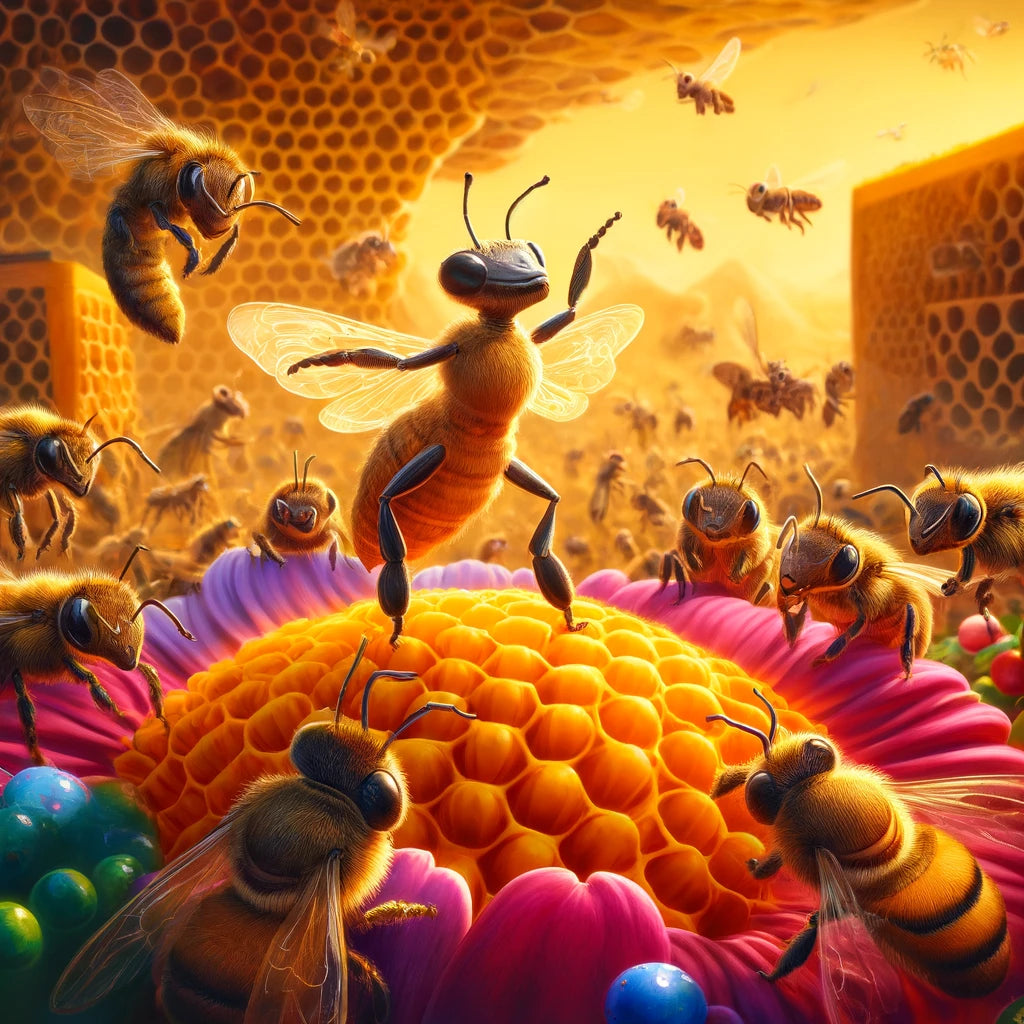Dive into the fascinating world of Apis mellifera, or the honey bee, a pivotal player in our ecosystem. These bees perform a unique "waggle dance," a crucial form of communication that bolsters their colonies' survival and, by extension, the health of our planet. This dance is a marvel of nature, essential for pollinating and affecting a wide range of plant species.
By exploring the intricate language of these remarkable creatures, we uncover valuable insights into their complex societies and learn how to support their existence amidst environmental challenges.
The Vital Role of Apis Mellifera
Apis mellifera plays an indispensable role in our ecosystem, primarily through pollination. This process is crucial for the reproduction of many plants, ensuring the survival of diverse ecosystems. The waggle dance is central to this activity, as it helps bees effectively communicate the locations of food sources.
This not only supports the health and productivity of the hive but also contributes to the balance of our ecosystems and the richness of our biodiversity. The survival of many plant species, and consequently the animals that depend on them, hinges on the effective pollination work of Apis Melifera. Therefore, understanding and supporting these bees is about preserving a species and maintaining our ecosystem's balance.
Decoding the Waggle Dance
The waggle dance, performed by forager bees, is a sophisticated form of communication that conveys precise information about the location of food sources. This figure-eight dance communicates the direction and distance of nectar and pollen from the hive. The duration of the waggle phase indicates the distance, while the angle of the dance to the sun provides direction.
This remarkable communication method highlights the honey bee's complex social structure and underscores the importance of its role in the ecosystem. By decoding the waggle dance, researchers and beekeepers can gain insights into how to support these essential pollinators better, ensuring the hive's health and the success of our agricultural and wild plant species.
Supporting Apis Mellifera Populations
Innovative solutions are crucial for maintaining healthy bee populations and ensuring ecosystem balance. Here's how we can support Apis mellifera:
- Use of Pheromone Products: Products like Swarm Commander Premium Swarm Lure mimic the natural pheromones of the queen bee. These can significantly attract and retain healthy bee populations in hives.
- Creating Bee-Friendly Environments: Planting bee-friendly flowers and reducing pesticide use can provide safer habitats for bees.
- Research and Education: Ongoing research into bee health issues and public education on the importance of bees are vital for their conservation.
Supporting honey bee populations not only helps in pollination but also preserves the biodiversity of our ecosystems.
Promoting Honey Bee Health Through Beekeeping Practices
Adopting sustainable beekeeping practices is essential for promoting the health and longevity of honey bee populations. Here are key strategies:
- Regular Hive Inspections: Beekeepers should regularly inspect hives for signs of disease or stress and take prompt action to mitigate any issues.
- Sustainable Honey Harvesting: Ensuring that bees have enough honey reserves to sustain themselves, especially during winter, is crucial.
- Providing Water Sources: Bees need access to clean water. Beekeepers can place shallow water containers near hives to meet this need.
Implementing these practices helps ensure that bee colonies remain healthy and productive, contributing to the resilience of our ecosystems.
The Global Impact of Honey Bee Apis Melifera
Apis Melifera supports biodiversity through pollination and have a significant economic impact globally. Their role extends beyond the production of honey and includes:
- Pollination Services: Many crops depend on Apis Melifera for pollination, which is crucial for food production worldwide.
- Biodiversity Support: Apis Melifera supports the health and diversity of natural habitats by pollinating various plant species.
- Economic Contribution: The agricultural value of Apis Melifera is measured in billions, highlighting their importance to global economies.
Therefore, the conservation of Apis Melifera is not just an environmental issue but a global economic necessity.
Conclusion
The significance of Apis mellifera and their waggle dance to our ecosystems cannot be overstated. Honeybees are vital in maintaining ecological balance and supporting biodiversity through their intricate communication and pollination work.
We must take action to support honey bee populations, including using products that promote bee health and conserving their habitats. By understanding and appreciating the complexity of bee communication, we can contribute to the sustainability of these essential pollinators and the ecosystems they support.
Frequently Asked Questions About The Importance of the Waggle Dance
Q: How does the waggle dance benefit Apis Melifera?
A: The waggle dance is a crucial communication tool that allows bees to inform their hive mates about the location, distance, and quality of food sources. This efficiency in foraging supports the hive's health, productivity, and overall survival.
Q: Can humans interpret the waggle dance without technology?
A: While challenging, researchers have developed methods to interpret the waggle dance through careful observation and analysis. This understanding helps in studying bee behavior and foraging patterns.
Q: What threats do Apis Melifera face today?
A: Apis Melifera face multiple threats, including habitat loss, pesticides, diseases, and climate change. These challenges necessitate concerted conservation efforts.
Q: How can individuals contribute to honey bee conservation?
A: Individuals can contribute by planting bee-friendly gardens, supporting local beekeepers, reducing pesticide use, and spreading awareness about the importance of bees to our ecosystem.



